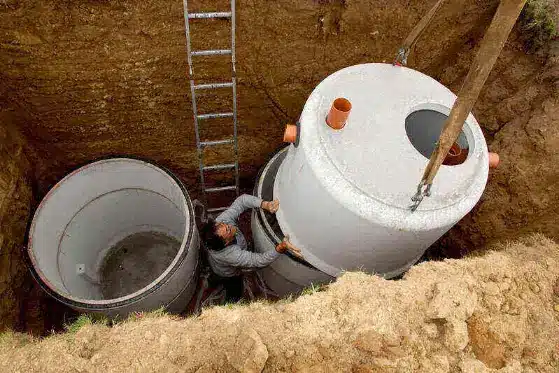Installing a Septic Tank is a significant undertaking that requires careful planning, consideration, and adherence to local regulations. Whether you’re building a new home or replacing an existing septic system, understanding the essentials of septic tank installation is crucial to ensuring a smooth and successful process.
In this comprehensive guide, we’ll cover everything you need to know before embarking on a septic tank installations project.
1. Assess Your Property and Soil Conditions

Before proceeding with a septic tank installation, it’s essential to assess your property and soil conditions to determine suitability. Factors such as soil type, groundwater levels, and topography can impact the design and placement of your septic system.
Conduct a soil percolation test, also known as a “perc test,” to evaluate the soil’s ability to absorb and treat wastewater. This information will inform the size and type of septic tank best suited to your property’s needs.
2. Understand Local Regulations and Permitting Requirements
Septic tank installations are subject to regulations and permitting requirements established by local health departments or environmental agencies.
Familiarize yourself with these regulations to ensure compliance throughout the installation process. Permitting requirements may include obtaining soil evaluations, submitting design plans, and securing permits before commencing construction.
Failure to adhere to these regulations can result in costly fines and legal consequences, so it’s crucial to do your homework and follow proper procedures.
3. Choose the Right Type and Size of Septic Tank
Septic tanks come in various types and sizes to accommodate different property sizes, soil conditions, and wastewater volumes.
The two primary types of septic tanks are traditional gravity-fed systems and modern aerobic treatment units (ATUs). Consider factors such as household size, water usage, and available space when selecting the appropriate tank size and type for your property.
Consulting with a qualified septic system professional can help you make informed decisions based on your specific needs and circumstances.
4. Plan for Proper Placement and Drainfield Design
The location and layout of your septic tank and drainfield are critical factors that can impact the system’s performance and longevity.
Choose a suitable site for the septic tank based on factors such as accessibility, setback requirements, and distance from wells, water bodies, and property lines. Design the drainfield to ensure adequate dispersion and treatment of wastewater, taking into account soil characteristics and hydraulic loading rates. Proper placement and design are essential for maximizing the efficiency and lifespan of your septic system.
5. Budget for Installation Costs and Maintenance Expenses

Septic tank installation involves upfront costs for materials, labor, and permitting fees, as well as ongoing expenses for maintenance and repairs.
Develop a realistic budget that accounts for all aspects of the installation process, including site preparation, excavation, tank installation, and drainfield construction.
Additionally, factor in long-term maintenance costs for routine pumping, inspections, and potential repairs or upgrades. Investing in proper installation and regular maintenance can prevent costly issues and prolong the lifespan of your septic system.
6. Consider Environmental Impact and Sustainability
Septic tank installations have environmental implications that should be considered during the planning and design phase.
Choose environmentally friendly materials and technologies that minimize groundwater contamination and nutrient runoff. Explore options for eco-friendly septic tank additives and alternative treatment systems that enhance wastewater treatment and reduce environmental impact.
Additionally, implement water conservation measures to reduce the strain on your septic system and preserve water resources for future generations.
7. Hire Qualified Professionals for Installation and Maintenance
Septic tank installation is not a DIY project and should be entrusted to qualified professionals with experience in septic system design and installation.
Research reputable septic tank contractors in your area and request multiple quotes to compare services and pricing. Verify credentials, licenses, and insurance coverage before hiring a contractor to ensure they meet regulatory requirements and industry standards.
Next, establish a maintenance schedule with your chosen provider to keep your septic system operating smoothly and efficiently for years to come.
8. Educate Yourself on Proper Operation and Maintenance
Once your septic tank installation is complete, it’s essential to educate yourself on proper operation and maintenance practices to prolong the lifespan of your system and prevent costly repairs.
Familiarize yourself with the dos and don’ts of septic system care, including avoiding flushing non-biodegradable items, conserving water, and scheduling regular inspections and pump-outs.
Be proactive in addressing any signs of system malfunction, such as slow drains, foul odors, or wet spots in the yard, to prevent more extensive damage and costly repairs down the road.
9. How to Choose the Best Septic Tank Installations Service
Choosing the best septic tank installation service is crucial for ensuring a smooth and successful project that meets your needs and budget. Here are some essential factors to consider when selecting a septic tank installation service:
- Experience and Expertise
Look for a company with extensive experience in septic system installation and a proven track record of success. Experienced installers have the knowledge and skills to handle various soil conditions, regulatory requirements, and system designs effectively.
- Reputation and Reviews
Research the reputation of potential installation services by reading online reviews, testimonials, and asking for references from past clients.
A company with positive reviews and satisfied customers is more likely to provide quality service and customer satisfaction.
- Licensing and Certification
Ensure that the installation service you choose is properly licensed and certified to perform septic tank installations in your area. Licensing demonstrates compliance with regulatory standards and ensures that the installer has the necessary qualifications and expertise to complete the job safely and effectively.
- Quality of Workmanship
Evaluate the quality of workmanship by reviewing photos of past installations and visiting completed projects if possible. Look for signs of attention to detail, proper installation techniques, and durable materials that will withstand the test of time.
Final Words
Septic tank installation is a significant investment that requires careful planning, adherence to regulations, and collaboration with qualified professionals.
By understanding the essential considerations outlined in this guide, homeowners can navigate the installation process with confidence and ensure the long-term performance and sustainability of their septic systems. With proper planning, diligent maintenance, and responsible stewardship, a well-designed and properly installed septic tank can provide reliable wastewater treatment for many years to come.






